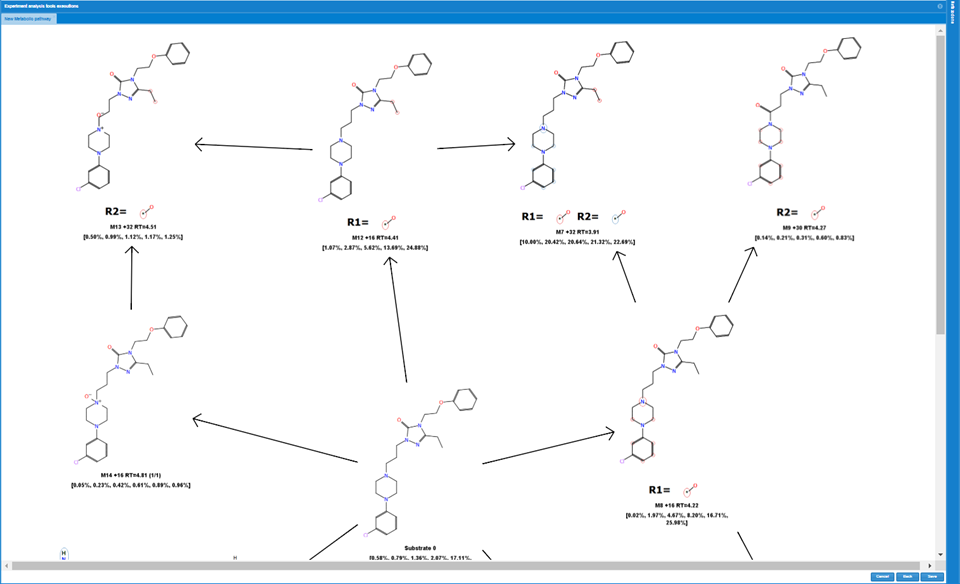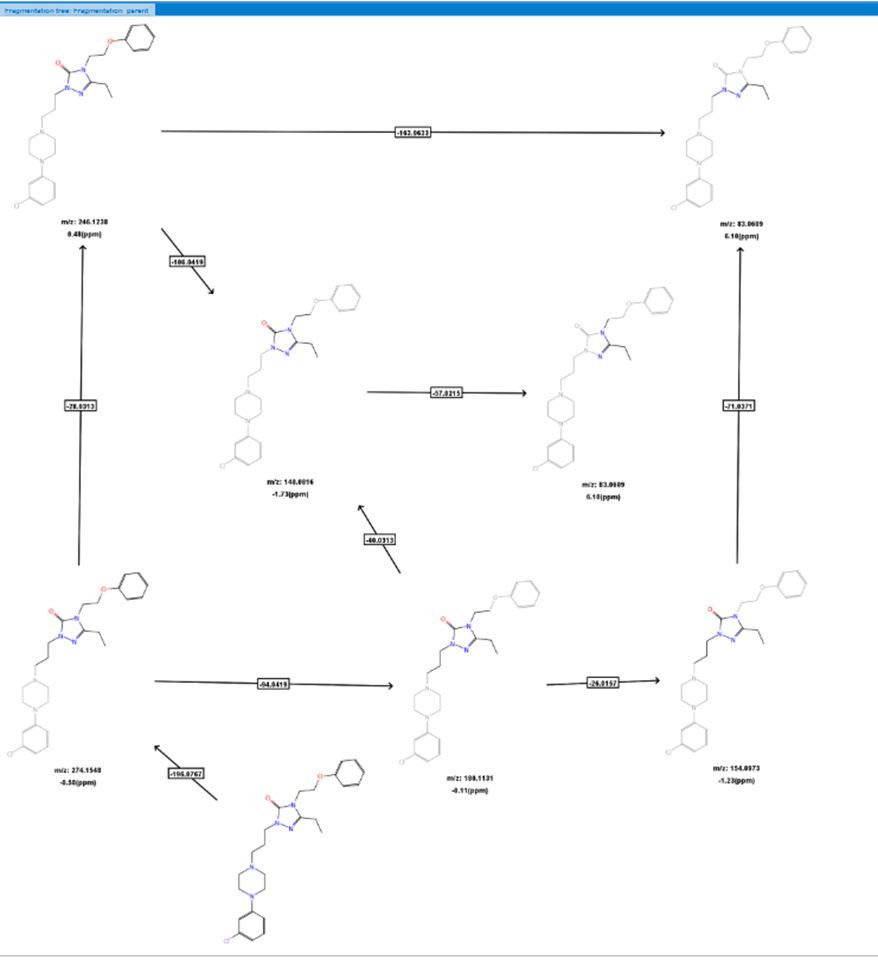Single Compound analysis tools
Flexible reporting tool based on templates
WebMetabase uses a Jasper report template base system. The user can get a report template from Molecular Discovery (upon request) or can generate a new report using the Jasper Studio. These report templates are later loaded as a report template into WebMetabase. Once they are loaded, they can be used to generate a report of an experiment manually or automatically based on the experiment data content.

Docking of the compounds in CYPS, FMO or AOx (Aldehyde oxidase) enzyme cavities
This tool aims to place the parent compound in the cavity of 3A4, 2D6 or 2C9 with the site of metabolism nearby the catalytic point of reaction of the binding site. In the case of the cytochrome P450 family this means to perform a restricted docking where the place where the metabolic reaction occurs (Site of Metabolism) is in the close vicinity of the oxyferryl species. This tool is designed to help the chemists in the understanding of the metabolism of the substrate by showing the potential interactions of the molecule with the different cytochromes provided a site of metabolism.
The user must select one of the metabolites under investigation, the system translates the atom(s) that have been transformed in the parent (SoM) to produce the structure of the metabolite and by selecting the cytochrome the computation will place the substrate with the atom that has suffered the metabolic reaction in the vicinity of the catalytic site of the CYP450, the heme group. This process is done in a 3D mode using the GRID Molecular Interaction fields and the Flap approach. The visualization of the results as done in such a way that the result orientation is reported in the Docking tool that has different layers of information:

MetaDesign: suggestion of structural modifications
This tool is designed to help the user in the design of new molecules having the same boosterism properties than the one under study by replacement of a selected part of the compound.
The workflow starts from a molecule and the selection of a fragment (query) that the user wishes to replace. The query-fragment can be selected manually or automatically based on the Site of Metabolism (SoM) of a detected metabolite. Once the fragment has been selected, it is compared by different techniques to an existing database of fragments, and the ones with the higher bio isosteric index are then processed to build new molecules where the query-fragment is replaced by the solution proposed by the search engine.

The results proposed by the methodology would depend on how the database of fragments has been built and on the search engine. In the next figure the process to build the database is shown. The starting point is a 2D Sdf file that contains Du to indicate the anchorage point between the fragment and the rest of the molecule. The 2D compound is then processed using the Moka tools (1,2), to find the right ionization state and tautomer at pH 7. The “curated” 2D structures are then processed to compile VS+ (3) like descriptors that describe the Physico-chemical properties of the compounds. The 2D structures are then converted in 3D and a random conformation search is performed. Each conformation is then submitted to the calculation of GRID molecular interaction fields (Hydrogen bond donor, acceptor, positively and negatively charge and hydrophobic interaction) (4). The 3D fields are transformed in a 2D vector that represents the interactions in 3D as a distance-based function (5,6). This set of descriptors is used to determine a principal component space where the query-fragment can be projected. The final database is keeping information about the Physico-chemical properties of the compounds, the distance-based function of the interaction and the principal component scores.

To search the query-fragment into the database it is converted to 3D and a conformation analysis is done, the search in the database is done on each of the conformers that have been found. The search strategy has seven processing steps:
Physico-chemical property filter: The fragments in the database are compared to the query one and only those ones within a certain window in the Physico-chemical parameters are selected. In addition, if the reactivity filtering option is set ON, only fragments with lower reactivity towards oxidation than the query is selected for the next step.
Principal property filtering. In this step the query-fragment is projected into a principal component space created by the fragments in the database. The fragments that are withing a certain Euclidean distance to the scores of the query one is selected for the next step.
Vector similarity analysis. (2D Similarity Score) The distance-based interaction vectors of the query are compared with the ones in the reduced set of fragments from the database. The ones that pass a certain threshold in the similarity between these fragments are selected for the next step.
The remaining fragments are then used in a Molecular interaction Field alignment in 3D. Each fragment that has been selected is aligned with the query one searching for the maximum overlap of the interaction fields in 3D (3D Similarity Score). The fragments that pass a certain threshold are used in the next step.
The selected fragments are used to build new molecules (the designed compounds) optimizing the 3D geometry of the junction between the fragment and the rest of the molecule.
Finally, the new designed molecules are converted to 2D for the user inspection.

Bibliography
- 1.Extending pKa prediction accuracy: high throughput pKa measurements to understand pKa modulation of new chemical series. Milletti F, Storchi L, Goracci L, Bendels S, Wagner B, Kansy M, Cruciani G. Eur J Med Chem. 2010 Sep;45(9):4270-9.
- Tautomerenumerationand stability prediction for virtual screening on large chemical databases. Milletti F, Storchi L, Sforna G, Cross S, Cruciani G. J Chem Inf Model. 2009 Jan;49(1):68-75.
- BDDCS class prediction for new molecular entities.BroccatelliF, Cruciani G, Benet LZ, Oprea TI. Mol Pharm. 2012 Mar 5;9(3):570-80.
- Molecular fields in drug discovery: getting old or reaching maturity? Cross S, Cruciani G. DrugDiscovToday. 2010 Jan;15(1-2):23-32.
- Anchor-GRIND: filling the gap between standard 3DQSARand the Grid Independent descriptors. Fontaine F, Pastor M, Zamora I, Sanz F. J Med Chem. 2005 Apr 7;48(7):2687-94.
- SHOP: ScaffoldHOPpingby GRID-based similarity searches. Bergmann R, Linusson A, Zamora I. J Med Chem. 2007 May 31;50(11):2708-17.
Metabolic pathway drawing tool
The tool for building metabolic pathways can be found inside the approved experiments. Users can build metabolic pathways that show the relationship between the parent drug and the metabolites. Metabolic pathways can be built using all metabolites from all conditions. The user can select the metabolites and the relationship between then and the parent to automatically draw the Metabolic pathway. In addition, the user can select:
- The data to be shown along with the chemical structures, like the type of signal to be shown in the graphic: no signal, MS area, relative MS area, UV area, relative UV area and Radio area.
- The format of the data to be shown in the case that the compounds has more than one condition and it is related on how the data for the multiple conditions are shown: Value range (min and max), maximum value, average value, or all values (comma separated).
- The grouping of the data: This option is used if there are more than one analysis variable in the experimental protocol used. The user can select to present the values groups by the values of an analysis variable. Only the analysis values with string type could be used for groups. The user can select to use a group to classify the result or not. When the option is clicked the groups by selection will be enable.
Fragmentation Tree
This option gives access to the previously saved results for fragmentation tree utility to study the fragmentation tree of the parent molecule. It will be a tree of fragmentation for the parent molecule.

Kinetic analysis
The kinetic analysis tool computes the rate of compound disappearance by doing a logarithmic of the time axis and calculating a regression line. The points to build the line are automatically selected to get the highest correlation coefficient with highest number of points giving the highest weight to the earlier time points in the analysis. After computing the half-life and the clearance the system also plots the sum of areas for parent and all metabolites for the different time points and the selected variables. Moreover, the system computes the slope of formation for each metabolite by calculating a regression line with the earlier time points obtaining the highest regression coefficient. Finally, the atoms in the parent that undergo the biotransformation reaction for each metabolite are automatically selected and a ring is plotted around each atom. The intensity of the color for this ring is proportional to the slope computed for the metabolite. All the metabolites that appear at the same initial time are shown in the same graphic. This information is shown in a new window:

